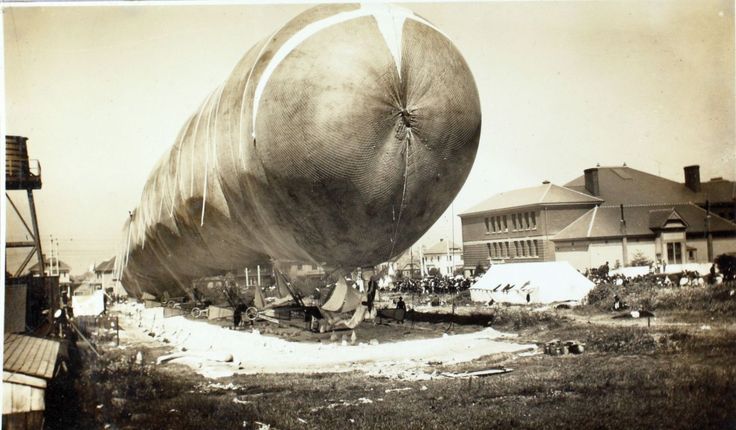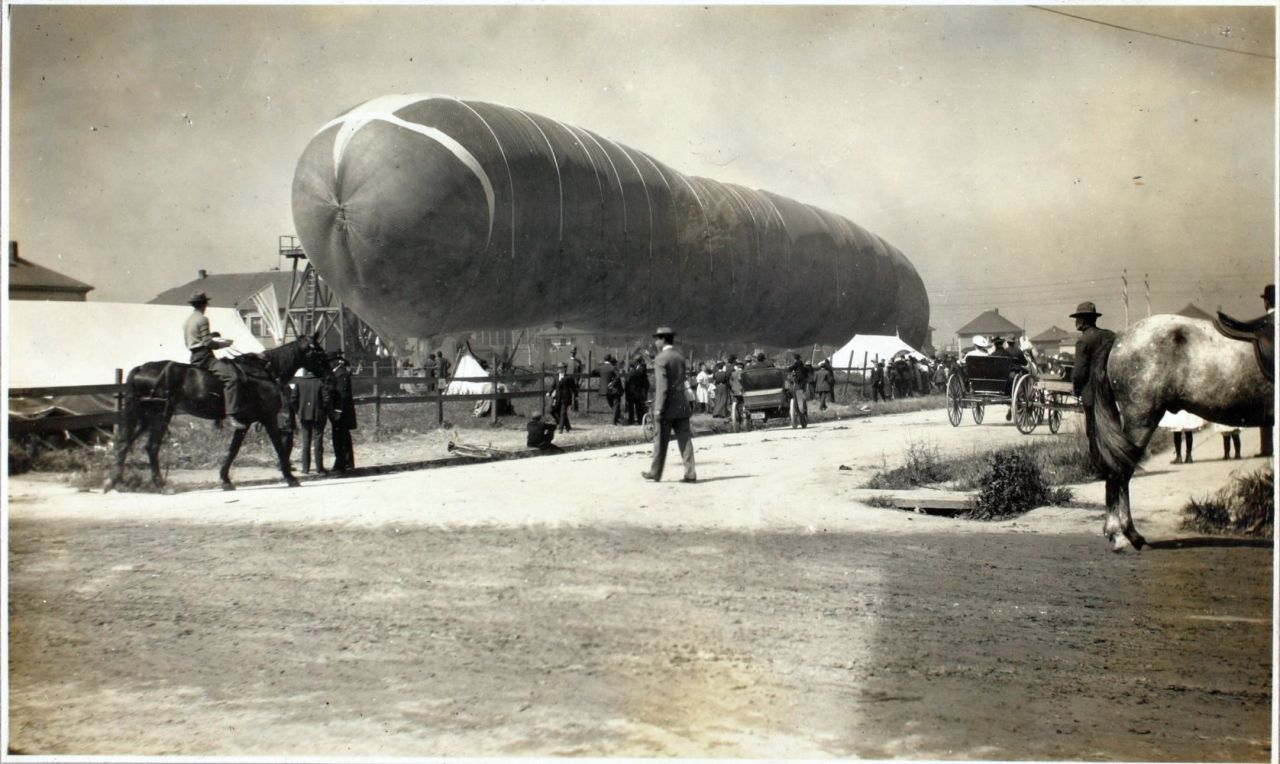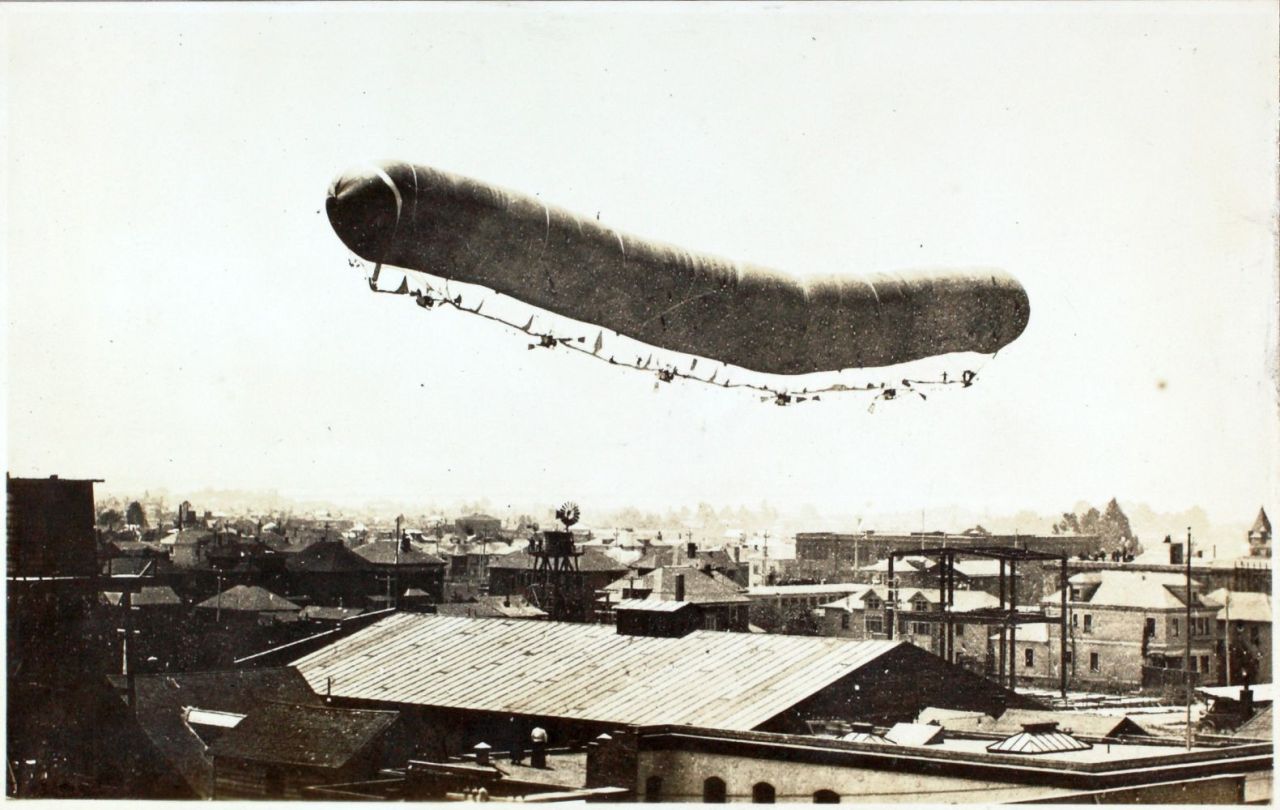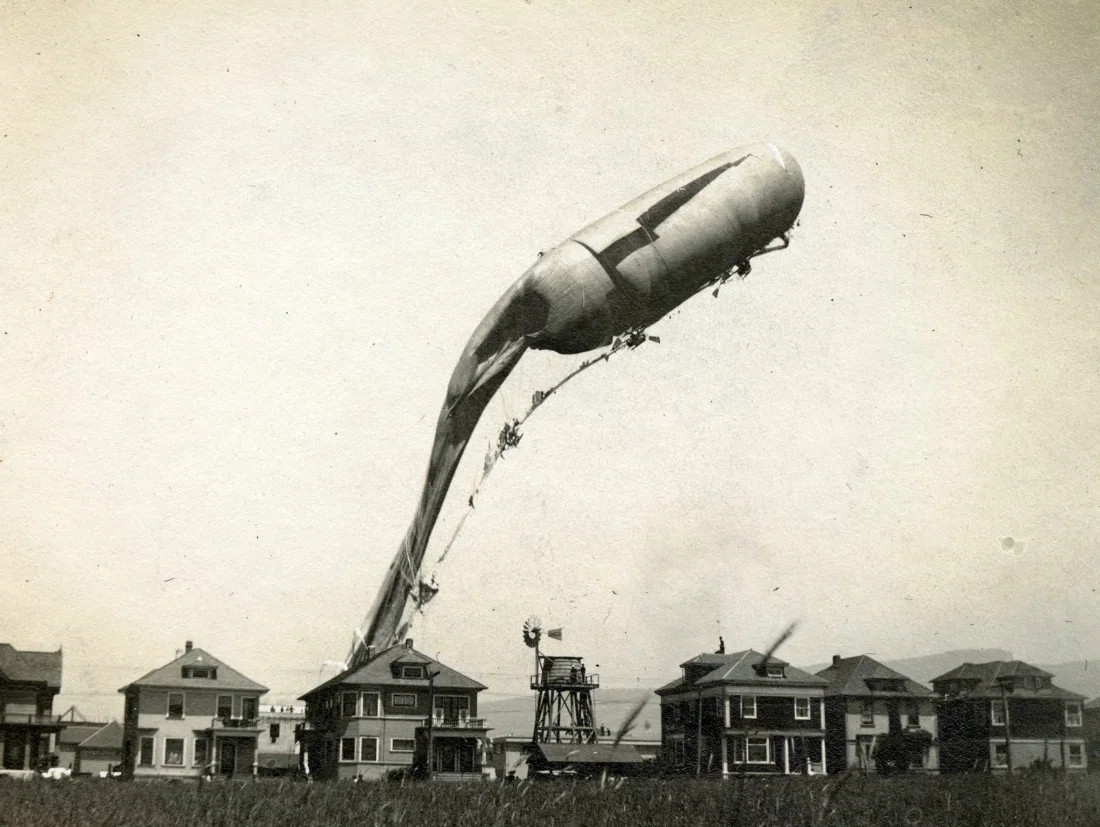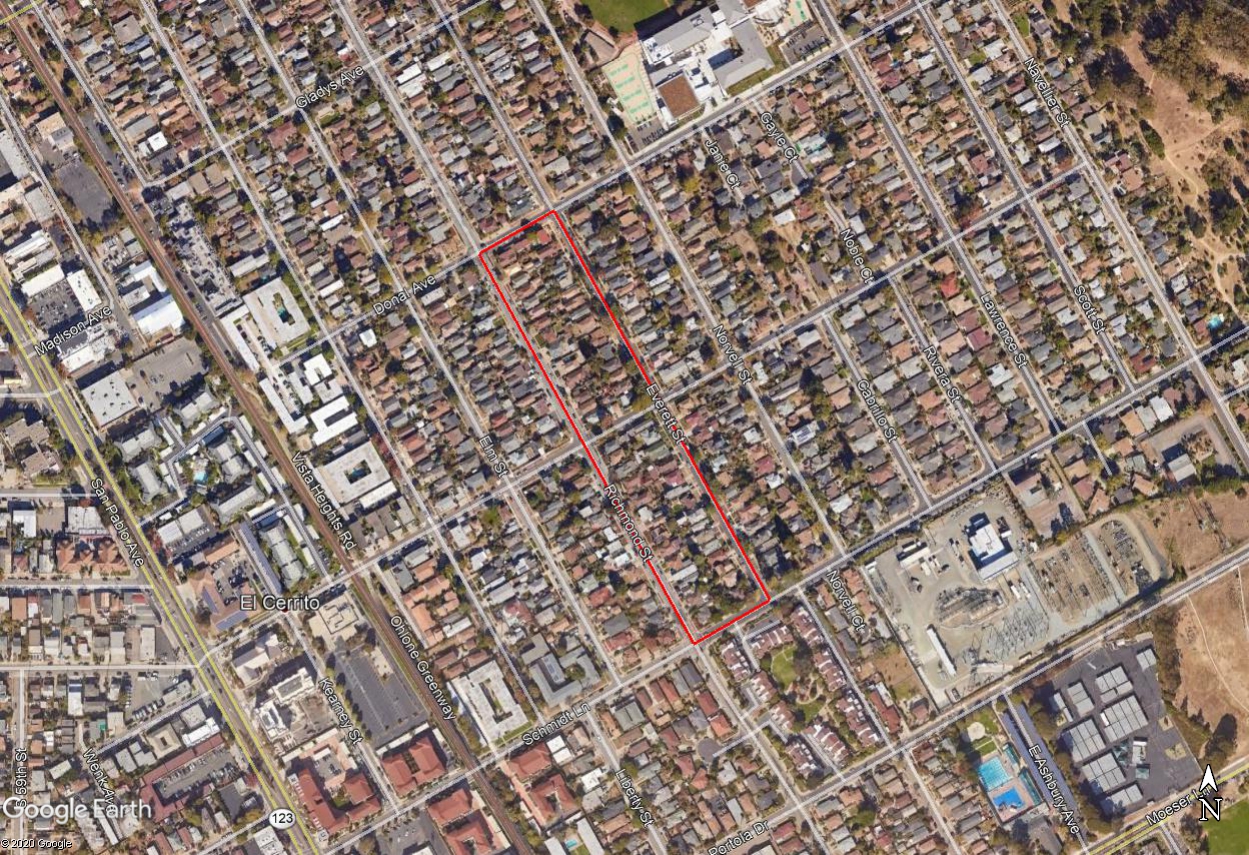Morrell Airship
The 2nd Morrell Airship ascends on its maiden and only flight, May 23, 1908, Berkeley, CA, USA
View is looking to the north. See text for location. Photo credit: thejivebombers.com/2018/01/29/1044/
This bizarre yet interesting airship which flew only once - sort of. It was the brainchild of San Francisco inventor John A. Morrell (often seen in error as "C. A. Morrell") who envisioned commercial dirigible balloon air service between California and Asia. He created a company, the "National Airship Company," seeking investors and seems to have had financial, engineering, and legal troubles from the very start!
The 1907 prospectus of the company declared the airship was to be named the "Ariel" and it was to be "1250 feet long, 64 feet in diameter" and to "carry 500 passengers and 40 tons of mail from New York to London at an expense of $875 in 24 hours" (Aeronautics Magazine, June, 1908, page 24.) The prospectus called for "landing docks on the tops of office buildings...on all the large cities of the world." Note that Morrell's ambitious plans proposed an airship over 1 1/2 times the length of the (then future) Hindenburg (which was 803 feet) which would not be built for another 29 years!
The proposed Morrell Airship "Ariel"
Photo credit: California History, Vol. 58, No. 4 (Winter, 1979/1980), pp. 334-347
Morrell had reportedly built "17 (demonstration) airships and 6000 gas balloons" and stated that his airships would "earn over $25,000 a day"! Needless to say, these claims resulted in him being labeled "the world’s most prolific liar" (Aeronautics Magazine, June, 1908, page 25.)
To bolster his claims, Morrell built a prototype - in secret - and attempt to fly the prototype on October 1, 1907. There are no photos of this craft and no definitive specifications found in print, but Morrell had released that his prototype would be "600 feet long and would carry himself and eight others". But on that first flight attempt in San Francisco, disaster struck:
RUNAWAY AIR SHIP CAUSES TROUBLE, Tied to Fence by Farmer, Breaks Away and Explodes
SAN FRANCISCO, Oct. 1. - An airship invented by J. A. Morrell of this city was scheduled to make a trial trip today but before the time fixed for its flight it broke loose from Its moorings and for several hours drifted over the Mission district. No one was on board, but this fact was not known to the thousands of people who watched its erratic course.
REDWOOD CITY, October 1. - At about 1:15 this afternoon an airship was observed here rapidly approaching from the direction of San Francisco. No one appeared to be in it, and the gas bag had tipped so that it looked like an immense sausage floating in the air. The ship was rapidly descending and by the time it was west of town ropes were trailing over the trees and housetops. When the ship reached the golf links at Fair Oaks, a large manilla rope trailing on the ground was caught by a farmer and hastily fastened to an oak trees, and the flight of the airship was stopped for the time being. Several smaller ropes were fastened to a fence, but about 2 o’clock the ship broke loose and rose rapidly and began its trip south, but had gone but a few hundred yards when the balloon burst into many pieces. The car and machinery of the airship were evidently lost before reaching here, as there was nothing of that character attached to the gas bag except a small portion of the platform intended for passengers.
San Jose Mercury News, October 2, 1907
Despite the setback, Morrell had his supporters. After a scathing note appeared in the press (San Francisco Morning Press 17 January 1908) and the February, 1908 issue of Aeronautics Magazine where it was reported that
"federal officers have started an investigation of the National Airship Company, San Francisco, and the first result of the investigation has been the disappearance of all the officials connected with the concern and with them what is left of stock sales amounting to more than quarter of a million dollars",it brought the following response from a shareholder published as a letter to the editor in the April, 1908 issue of Aeronautics:
To the Editor:
I notice a mention of the National Airship Company of San Francisco, in February AERONAUTICS under the head of “Notes.”
Although I am not connected with the Company other than a small stock holder, I am anxious with other stockholders to see our Company a success. And such misleading articles tend to militate against the best interests of the Company.
Your correspondent states that all the officials connected with the concern have disappeared, and with them what is left of the stock sales, amounting to more than a quarter of a million dollars.
After I heard of the trouble I went over to San Francisco and found Mr. Morrell in the office working at a typewriter. He said he had been in the office every day, notwithstanding the report that he had absconded with the funds. He says he has paid out twenty-seven thousand dollars more than received for the sale of stock; never sold a share of personal stock and never accepted a dollar for personal services, and has worked more than fourteen hours per day during three years since the Company was organized. He says the Ariel will be built, if he is let alone, and do all that he has ever claimed for it. Where the malicious articles claim that the federal officers were asked to investigate on the complaint of hundreds of stockholders, Mr. Morrell says that only two stockholders have made any complaint, and these two are connected with other airship companies, and have an interest to down him.
I do not pretend to say how this trouble will come out. But there are certainly misstatements abroad concerning the Airship Company that should be corrected.
Very truly yours,
W. S. HASKELL,
Berkeley, Cal., Feb. 28, 1908.
And so it seems an "Ariel", of sorts, was built, or at least a prototype of the proposed airship, which met a quick demise. Morrell retreated to his shop and under pressure from hundreds of stockholders in his company, prepared a 2nd airship and that is the subject of the remainder of this investigation.
Construction of 2nd Prototype
Morrell Airship inflation at Berkeley. Looking east southeast.
Photo credit: https://mrdingo.tumblr.com/post/143679026676/the-morrell-airship-collapse-23-may-1908-five/amp
The National Airship Company was incorporated in South Dakota but its place of business was reportedly at 1780 Market Street in San Francisco, CA though an earlier (or 2nd) address may have been at 61 Van Ness Avenue according to a Jan 16, 1908 San Jose Times report. It is unknown if either location contained shop/warehouse space adequate to house the necessary machinery, supplies, and workforce needed to build a giant airship, but nevertheless San Francisco is where the "Ariel" was developed. Today, at both locations, a modern multi-floor office building exists - certainly looking nothing like what they must have in 1908.
After the October, 1907 failed flight attempt and complete loss of his first prototype, under mounting stockholder pressure, and law suits accumulating, Morrell announced he'd have a passenger-carrying airship ready to fly by April, 1908.
But sometime in late 1907 or early 1908, the City of San Francisco denied Morrell permission to build and test launch his airship (likely after Morrell's failed "surprise" flight attempt in San Francisco in October, 1907), so Morrell applied to the City of Berkeley. Berkeley Police Chief August Vollmer approved the proposal, it is recorded, "despite his personal reservations" since there were no objections from city authorities.
Wherever Morrell's warehouse was where the airship components were developed, Morrell and his crews arrived in Berkeley in mid April, 1908 to a designated empty lot in Berkeley (see "Sites of Interest" below) and pitched tents for accommodation and workspace and proceeded to build the airship!
Morrell and his crew built a gargantuan behemoth 450 feet long, (150 feet shorter than his first prototype and nowhere near the proposed 1250 foot long airship he planned!), and 36 feet in diameter. (This is actually a bit smaller than the first prototype which broke away and crashed on October 1, 1907.) Here are the specifications of the "new" airship, as-built on-site, as best as could be determined by available sources:
Specifications:
- Length: 450 ft (137 m)
- Max Diameter: max 36 ft (11 m)
- Envelope ratio (L/D): 12.5. [Note: This L/D is unprecedented. Most airships had a L/D ratio under 8. The Morrell design was 12 times longer than it was in width (diameter)!]
- Envelope: Some information suggests that the envelope was "doped canvas", an "unbleached cotton canvas, covered with a coat of paint or varnish", (Popular Mechanics, July, 1908). Later reported to consist of "old cloth formerly used in a smaller balloon was sewed in with the new" (Popular Mechanics, September, 1908.) That's hard to believe as canvas would have been very, very heavy.
- Power: Five, 60 hp gasoline engines spaced 60 feet apart.
- Gas Capacity: 485,000 cu ft. [Note: Morrell used "city gas" or illuminating gas and did not produce his own hydrogen.]
- Estimated lift: About 12,000 lbs.
- Speed: Unknown. (Never demonstrated).
- Passengers/Crew: Crew of 16 men, 3 photographers and an uninvited aeronaut (see text) though 22 names are found in the various newspaper articles covering the airship.
- Operating dates: Never Operational. Built in the open air in April and May, 1908, and had only one attempted, disastrous flight on May 23rd.
- Visual: A rather ridiculous "worm-like" shape, far, far longer than its envelope diameter. No rigid framework, no rigid keel. Netting surrounded the entire gas bag, and the keel which consisted of a rather flimsy catwalk.
Operations
It's a bit hard to describe "operations" of the 1908 Morrell prototype airship since there was only one flight attempt... This being the second Morrell airship failure, the envisioned "fleet" of passenger-carrying airships subsequently never had a chance to become a reality.
The "National Airship Company" already troubled from the start was getting bad press. In January, 1908, The San Francisco Morning Press writes (in a headline):
"National Airship Company" Sells $250,000 in Shares, But President Disappears When Subpoena Is Served Upon Him
... On Sunday [Jan 12, 1908], Morrell was served with a subpoena to appear in Portland next week and explain the status of his company to the authorities. Since then, it is asserted that he has disappeared.
This information was repeated and expanded in the February 2nd, 1908 "Aeronautics" magazine as reproduced here:
Acting on the complaint of several hundred stockholders, federal officers have started an investigation of the National Airship Company, San Francisco, and the first result of the investigation has been the disappearance of all the officials connected with the concern and with them what is left of stock sales amounting to more than quarter of a million dollars. The company was promoted to secure $1,000,000 with which to build an airship that would be the greatest thing ever imagined. More than 250,000 shares of stock were sold. It claimed that the intention was to construct an airship 1,250 feet long, 64 feet in diameter, of 140,000 cubic yards capacity and 128 tons displacement, with eight independent power plants, and engines developing 3280 horsepower turning 16 propellers. Forty men, as advertised, were to compose the crew, and the airship to carry 500 passengers and 40 tons of mail from New York to London at an expense of $875 in 24 hours, "every day in the year, regardless of weather conditions." Regular trips were advertised between Portland and San Francisco.
Many other claims of future accomplishment taxing the power of credulity to the breaking point were made in the matter, which is said to have gone through the mails. The company advertised, further, that it would issue checks in payment of dividends January 1, 1908, but this is said not to have been done.
This brought a letter to the editor of "Aeronautics" from W. S. Haskell, shareholder, which was carried in the April, 1908 edition of "Aeronautics" and is reproduced above.
No matter Morrell's legal tangles, the same month of that April edition of "Aeronautics", J. A. Morrell did build a second airship on a street in Berkeley, California (see below). That one flight took place on May 23, 1908.
At noon, when preparations were completed, the crew climbed aboard - except George Loose, the man Morrell hired to build the airship. Loose and other observing aeronauts warned Morrell that it was consummately unsafe, but Morrell, pressed by his financial backers, refused to heed their warning.
So to the accompaniment of a wildly cheering crowd, the giant airship rose to an altitude of about 300 feet. Then disaster hit. Suddenly the dirigible became lopsided, and the mammoth gas bag burst, sending engines, propeller and men hurtling to the ground on top of the horrified crowd. A reporter for the [San Francisco] Call reported that 'a crew of 16 men, three photographers, and an aeronaut attempted the flight, and of those, nine men, including the inventor, were picked up unconscious, their limbs broken.' (Kurutz, California History, Vol. 58, No. 4 (Winter, 1979/1980), pp. 334-347.)
Morrell Airship just after launch, May 23, 1908. Looking South.
Photo credit: July, 1908 Popular Mechanics
Demise
Summary of the ill fated Morrell airship
The flight was described in the July, 1908 "Popular Mechanics" as "The most ambitious flight of a dirigible balloon ever attempted in the United States, and probably in the entire world..."
The Morrell airship, inflated, though this photo was taken late the day so it was not the day of the flight
(see the shadows). This shot is looking toward the northeast at the aft-end of the airship.
Photo credit: https://mrdingo.tumblr.com/post/143679026676/the-morrell-airship-collapse-23-may-1908-five/amp
But the article goes on to say:
"... met with disaster at Berkeley, Cal., on May 23, when the Morrell airship, 450 ft. long, collapsed 300 ft. above the earth, hurling its 16* occupants, by far the largest number ever attempting a flight in an airship, to the earth in a maimed and bleeding mass."
*The reporter was presumably only addressing the 16 injured men, there were likely a total of 22 men on board.
The disaster unfolds. Seen here, aft is to the left. The "bend" in the airship is a telltale sign that something
is already wrong. The bend can only increase the pressure in the already stressed envelope. The rent in the envelope
likely happened soon after this photo was taken. The photo was taken from the roof of the "Berkely Gazette"
at the time. Looking NE.
Photo credit: https://mrdingo.tumblr.com/post/143679026676/the-morrell-airship-collapse-23-may-1908-five/amp"The first trouble was encountered just before the flight upward was taken. Morrell had difficulty in getting his men to hear orders, and the airship wobbled dizzily from its guy ropes and anchors. One end of the bag appeared full and distended, but the other end sagged inward and appeared to be of uncertain quality. Finally the long cigar-shaped stretch of canvas straightened out evenly and appeared to swim into equilibrium. Morrell dropped his hat as a signal to let go and the men below began to loosen the ropes. There was some irregularity noticeable in the doing of this and one end of the ship shot upward considerably in advance of the other. The airship continued to rise - a strange-looking engine of flight with the crew clinging to the canvas keel swinging from the mesh of the gas bag."
And next:
"At a height of 300 ft. there was a sharp crackle of the bag, and a lengthwise rent appeared near the center. The forward end crumpled up like paper, and the whole assemblage of balloon, engines and occupants shot toward the earth. The flight upward and the fall to earth again took no more than 5 minutes."
The disastrous rip in the envelope has released all the lifting-gas in the forward end of the airship and it has
settled to the earth. Here, a "new" rent is clearly visible in the aft end, still aloft! The photo was taken looking south.
Photo credit: https://thejivebombers.com/2018/01/29/1044/
The photo immediately above is most disturbing. It shows an untested, poorly designed airship in mid disaster, crashing right after it was launched in a populated area. At the time of this photo the bulk of the accident has already happened, yet the still buoyant aft-section of the airship remained aloft. The photo apparently was snapped at the precise moment the remaining inflated aft section of the airship rent. With the pressure suddenly released, this remaining section must have rapidly fallen. Indeed, newspaper reports record that the aft section did come crashing to the ground. It is truly remarkable that none of the 22 on board the ill-fated airship died.
This, to me, is a telltale sign that the design of the envelope is most definitely to blame for the entire disaster. The entire envelope catastrophically failed! First, with no internal ballonettes, and the illuminating gas free to migrate to the highest point, the weakest part of the envelope near the forward part of the airship ripped under the pressure upon initially climbing and unequal stress on the structure due to the poorly designed, flexing keel. Then, even the remaining aft portion of the airship, still aloft, containing the only remaining illuminating gas - ruptured under the stresses of the mass hanging below it!
The Crew, Stowaways, and the Aftermath
Sixteen men suffered injuries with many serious - broken bones or internal injuries - or both. Two of the most serious were not expected to live but none died in the accident, and no one on the ground, workers, spectators, or the 4 other men on the airship. Morrell himself suffered a broken leg, a dislocated hip, and internal injuries and was confined to a hospital bed for two months.
But 5 of 22 on board were stowaways! Morrell demanded they disembark, but they refused or simply stayed on board when Morrell was distracted by other tasks. Only one of the photographers was authorized to fly, but 2 other photographers were on board along with 1 assistant. At least one stowaway was a Morrell employee, and the 5th stowaway was a well-known aviator.
Vincent P. Taylor, well known as an Australian aeronaut who went by "Captain Penfold" for his balloon and parachute aerial stunts, made the flight against the wishes of inventor Morrell - as a stowaway - and was dragged out of the wreck with both legs broken at the ankle!
The August, 1908 issue of Popular Mechanics reported an interview with Taylor:
He [Taylor/"Penfold"] had been an interested watcher of the work of preparing the huge dirigible balloon for the flight on May 23, and had made preparations to be one of the party. On the day of the flight C. [sic] A. Morrell, the inventor, tried to dissuade him from going, but when the ship left the ground he was on board.
"I was near the center of the airship and Mr. Morrell was standing a few feet distant. The ship had risen gracefully and presented a magnificent sight. Not a breath of wind was stirring as we rose to an altitude of 300 ft. While the cheers of thousands came floating up to us the rope near the center of the huge gas bag cut through the covering, and it collapsed. I shot a quick glance at Inventor Morrell and instinctively clutched at my parachute ropes. My hands touched nothing familiar. I was in an airship, not in my balloon. I missed the parachute, missed it horribly, and yet if I had had it, it would not have availed me, as we were too dose to the earth for its use. You see, in a balloon of the kind used in spectacular ascensions the only way to get back to earth is to fall, and we prepare for it, but in an airship there is no way to fall but hard.
"The fall was not rapid, or at least, not to me, and the accident might easily have had far more fatal results. The rear portion, as shown in one of the illustrations, held some gas, and the crew near that end escaped practically unhurt. We, in the center and forward end, however, came down hard enough to realize we had reached solid earth again, and I for one, was not sorry after the first shock was over."
The San Francisco Call, 26 May 1908 reported:
Wreckage from C. [sic] A. Morrell's airship which collapsed Saturday in midair was being cleared away today [May 25th] from the lot at Kittridge [sic]and Grove streets, the scene of the ill fated balloon's flight. Workmen packed the broken apparatus and engines preparatory to shipping the stuff back to Morrell's shops in San Francisco. Employees of the airship concern said that the company would continue at its headquarters, 1780 Market street, San Francisco.
...Chief of Police Vollmer's emphatic declaration that no more Morrell airships will be permitted to find place in Berkeley has disposed of the possibility of rebuilding the wrecked machine here. Vollmer asserted that he would call the attention of the county authorities to Morrell in case the balloonist should attempt to go ahead again in the vicinity of Berkeley.
And the September, 1908 issue of Popular Mechanics reported:
It is now believed that the cause of the wreck of the Morrell mammoth airship at Oakland was some poor material used in the bag. In order to save on material a quantity of old cloth formerly used in a smaller balloon was sewed in with the new. A case of new wine in old bottles. When the strain came, as the weight was borne by the bag, the weak portion was cut through by a guy rope supporting the second engine. When once the rip started there was no checking it.
Forgotten Hero of the Flight! John Byrne.
Take a good, close look at the 1st, 7th, and 8th photo in this article! Note the silhouette of a MAN on top of the envelope! That's John Byrne, a valve tender assigned to the gas valve above the 3rd & 4th engine toward the middle-aft of the airship. Here are closeups of the three photos showing John Byrne at his post:
John Byrne, Morrell employee assigned to the TOP of the ill-fated airship
Photo credit: Composite of 3 photos credited above.
The May 24, 1908, San Francisco Call newspaper wrote this about him:
Thousands Cheer Daring Aeronaut in Fight for Life After Explodes
Perched more than 400 feet in the air as the Morrell airship stood on end after the explosion, John Byrne probably, created more interest than any man who survived the aerial accident. As soon as the big bag split, Byrne, who had been waving an American flag, commenced to climb rapidly to the top, while thousands of spectators watched him breathlessly, thinking that he would be dashed to the ground before the gigantic airship reached the earth.
Byrne, who was probably the coolest man who made the hazardous flight, told the following graphic account of his experience:
"l rode on top of the ship and had charge of a valve just above the fourth engine. The cheering of the thousands of people gathered at the initial trial of the ship thrilled me and I seized a large American flag, which I had carried with me, and waved it backward and forward several times.
"Meanwhile the ship was steadily rising in the air, horizontal at first, then with a little dip at the forward end. I paid little attention to it however, as I was busy with the workings of the valve assigned to mo by Captain Morrell.
"The first intimation of the collapse of the bag that I had was when I heard a 'pouff,' as though somebody had a pair of bellows near me. Immediately I smelled escaping gas and knew that something was wrong.
The forward end of the great bag dropped suddenly and the shouts of the people far below changed to groans of horror. I heard their frantic cries and commenced to climb to the top of the bag as fast as l could.
"My move was none too soon, for just then I heard a rip of the canvas bag below where I clung to the netting, and a large volume of gas escaped. The bag stood up perpendicularly and I climbed to the top like a monkey. Hand over hand I went up the rigging, and it seemed miles to the top.
"I had just reached the top when the bag below me seemed to wilt up and slowly sink down. The spectators of the airship ascension cheered me in my climb to the top, but when the bag commenced to sag at the end all was quiet, except for an occasional scream by one of the women below me in Kittredge street.
"Although it seemed an incredibly long time, the upper end of the bag, on which I was riding, fell to the ground near where the airship had made its ascension, and I jumped for the ground, which was about 25 feet off.
"Luckily, the folds of the canvas still containing gas broke my fall and I landed in the lot with but a few bruises of a minor nature."
"Byrne was one of the coolest men of the entire crew both during and after the accident. He had been selected by Morrell to ride on the top of the big canvas because of his presence of mind.
He was one of the first to come to the aid of his companions buried under the weight of the canvas bag, and he plied his knife freely in cutting the valuable bag to release those hidden under its folds. His coolness won for him the praise of the spectators who crowded around to congratulate him on his escape.
Morrell's Troubles Continued
As mentioned at the outset of this article, Morrell already had legal troubles before his airship company had produced anything that might fly. As one can imagine, after the disaster, well, his legal troubles mounted.
On the 24th of June, 1908, Alexander Ots (sometimes misspelled in newspapers as "Otts"), who had been Morrell's "superintendent of construction" and stockholder in the company, sued Morrell for fraud claiming Morrell sold stocks and converted the money for his own use - i.e., embezzlement. This suit was in addition to the charge against Morrell, already on trial for issuing a "false prospectus" for which Morrell was ultimately acquitted in July that year.
In September, 1908, for a second time, Ots had Morrell arrested on a charge of felony embezzlement.
In October, 1908, Ots made his case for embezzlement before a grand jury! That same month, Ots formed a new airship company, the "Rekar Helicopter airship company", (October 2, 1908 San Francisco Call) with Ots the majority stockholder - 150,000 shares at $0.01 each!
In July, 1909, Morrell sought a dismissal of the charges on grounds that he, Morrell, was willing to go to trial and Ots refused the same. In the same month, newspapers reported that Morrell was at work on his next airship.
And finally, in August, 1909, charges of embezzlement were brought against Alexander Ots, sworn out by none other than Morrell himself! Ots was charged with embezzling 21,000 shares of stock in the "Stanley airship company" at a value of $21,000!
After August, 1909, I found no further newspaper reports on the Morrell-Ots battle! Curiously, there was one, intriguing report about Morrell's plans. It seems that as of Aug, 1909, Morrell still had his sights on building his 1,200 foot airship because he purchased a large plat in what is today El Cerrito, California. The August 8th, 1909 San Francisco Call reports that Morrell bought the plot bounded by Schmidt lane, Everett, Richmond and Donal streets. This was, of course, easy to find and is in the section immediately below, "Sites of Interest." Unfortunately, residents in the area heard of Morrell's plans and the paper reports that they planned to hold a mass meeting to protest against the airship as "unsafe and unscientific".
No further newspaper reports were found about Morrell and his airship plans. What became of Morrell is unknown to this researcher.
Sites of Interest
Berkeley, California
The site of the construction, launch, and demise of the Morrell airship is well known. Today, its on the grounds of Berkeley High School and the Berkeley Community Theater. In 1908, however, Kittredge St ran west to Grove Street (now called Martin Luther King Jr. Way). The airship was built on the north side of Kittredge and the Lat-Lon of the area is 37.868020, -122.271744.
Morrell Airship being constructed. Looking North.
Photo credit: Louis Stern Collection, from Spring 2006 Newsletter of the Berkeley Historical Society.
El Cerrito, California
As the text immediately above under the section titled "Morrell's Troubles Continued" revealed, Morrell seems to have intended to continue his efforts to build his 1,200 foot long commercial airship. Morrell purchased the plot seen here in what is today known as El Cerrito, California. Of course, Morrell never used the plot for any airship building but it is interesting to know where it might have happened! The plot is located at (Lat Lon) 37.917639 -122.307189, and bounded by the streets shown in this map:
Morrell's Last Stand. His property in El Cerrito where he planned to build his 1,200 foot airship.
Photo credit: Google Earth.
Click here to view this location in Google Maps.
I hope you enjoyed discovering this lost history of the Morrell airship and finding where it was built and enjoyed a very brief existence.
Bill Welker
Colorado Springs, CO, USA
April, 2020




